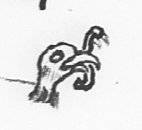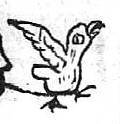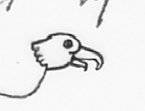MH: ATENCO - 387_666v
Glifo - 387_666v_41
Lectura: tlotli

Morfología: halcón, gavilán
Descomposicion: tlo-tli
Contacto: labios
Cita: tlotli
https://tlachia.iib.unam.mx/glifo/387_666v_41

tlotli
Paleografía:
TLOHTLI
Grafía normalizada:
tlotli
Tipo:
r.n.
Traducción uno:
faucon (nom générique). / faucon des prairies. / nom pers.
Traducción dos:
faucon (nom générique). / faucon des prairies. / nom pers.
Diccionario:
Wimmer
Contexto:tlohtli, pluriel tlôtlohtin (Sah11,44), var. tohtli (Sah11,43).
1.£ faucon (nom générique).
Michel Gilonne 1997,193.
2.£ faucon des prairies.
Faucon, épervier dont le corps est noir à l'exception des pattes et du bec qui sont jaunes.
Gauilan. Dyckerhoff 1970,272.
Sah9,60 traduit tlohtli par 'prairie falcon' (Falco mexicanus).
Décrit en Sah11,43.
" in yehhuâtl tlohtli quiyôllôtiâya in Huitzilopochtli îpampa ca quihtoâyah in yehhuântin tlotlohtin inic êxpa tlacua in cemilhuitl iuhquimmâ câtlîtiah in tônatiuh îhuân îpampa in ihcuâc câtlih eztli moch quitlaniah ", ce faucon communiquait avec Huitzilopochtli car on disait que ces faucons mangent trois fois par jour comme s'ils donnaient à boire au soleil et parce que, quand ils boivent du sang ils le consomment entièrement - this falcon gives life to Uitzilopochtli because, they said, these falcons, when they eat three times a day, as it were give drink to the sun ; because when they drink blood, they consum it all. Sah11,44.
" in âcôlpan contlahtlâliah tlohmâitl, yehhuâtl in tlohtli îâhmatlapal nenecoc in âcôlpan conihilpiliah, âmatl inic tlatzinquimilôlli ", sur les épaules ils placent des ailes de faucon, ces ailes de faucon ils les attachent de chaque côté sur les épaules, leur base est enveloppée de papier - on (each of) his shoulders they placed a prairie falcon's wing; they bound on each shoulder the paper which was wrapped about the base (of the wings).
Décrit la parure de celui qui est destiné au sacrifice. Sah9,60.
Note: Der 'tlohtli' genannte Raubvogel oder Teile deselben als Schmuckstück oder Trachtelement werden in der Form tlohmâitl wörtlich 'Falkenhand' von Sahagun genannt (Sah2,105 Sah9,60 = Sah Garibay I 185, III 51)
U.Dyckerhoff 1970,272.
" hueyi tlohtli ", sacre, grand faucon.
Note: 'Sacre', grand faucon de l'Europe méridionale et de l'Asie. Le sacre était trés employé autrefois à la chasse: difficile à dresser et à chaperonner il était cependant très estimé. Les fauconniers réservaient le nom de 'sacre' à l'oiseau femelle: le male était appelé 'sacret'.
Cf. 'iztac tlohtli' dont il est dit en Sah11,44 'îtôcâ sacre', son nom est (également) Sacre.
En composition tlohtli pourrait également désigner des engoulevents. Cf. yohualtlohtli.
3.£ nom pers.
Fuente:
2004 Wimmer
Gran Diccionario Náhuatl [en línea]. Universidad Nacional Autónoma de México [Ciudad Universitaria, México D.F.]: 2012 [29-08-2020]. Disponible en la Web http://www.gdn.unam.mx/contexto/73824
MH: ATENCO - 387_666v
Elemento: tlotli

Sentido: halcón, gavilán
Valor fonético: tlotli
https://tlachia.iib.unam.mx/elemento/02.01.52

tlotli
Paleografía:
TLOHTLI
Grafía normalizada:
tlotli
Tipo:
r.n.
Traducción uno:
faucon (nom générique). / faucon des prairies. / nom pers.
Traducción dos:
faucon (nom générique). / faucon des prairies. / nom pers.
Diccionario:
Wimmer
Contexto:tlohtli, pluriel tlôtlohtin (Sah11,44), var. tohtli (Sah11,43).
1.£ faucon (nom générique).
Michel Gilonne 1997,193.
2.£ faucon des prairies.
Faucon, épervier dont le corps est noir à l'exception des pattes et du bec qui sont jaunes.
Gauilan. Dyckerhoff 1970,272.
Sah9,60 traduit tlohtli par 'prairie falcon' (Falco mexicanus).
Décrit en Sah11,43.
" in yehhuâtl tlohtli quiyôllôtiâya in Huitzilopochtli îpampa ca quihtoâyah in yehhuântin tlotlohtin inic êxpa tlacua in cemilhuitl iuhquimmâ câtlîtiah in tônatiuh îhuân îpampa in ihcuâc câtlih eztli moch quitlaniah ", ce faucon communiquait avec Huitzilopochtli car on disait que ces faucons mangent trois fois par jour comme s'ils donnaient à boire au soleil et parce que, quand ils boivent du sang ils le consomment entièrement - this falcon gives life to Uitzilopochtli because, they said, these falcons, when they eat three times a day, as it were give drink to the sun ; because when they drink blood, they consum it all. Sah11,44.
" in âcôlpan contlahtlâliah tlohmâitl, yehhuâtl in tlohtli îâhmatlapal nenecoc in âcôlpan conihilpiliah, âmatl inic tlatzinquimilôlli ", sur les épaules ils placent des ailes de faucon, ces ailes de faucon ils les attachent de chaque côté sur les épaules, leur base est enveloppée de papier - on (each of) his shoulders they placed a prairie falcon's wing; they bound on each shoulder the paper which was wrapped about the base (of the wings).
Décrit la parure de celui qui est destiné au sacrifice. Sah9,60.
Note: Der 'tlohtli' genannte Raubvogel oder Teile deselben als Schmuckstück oder Trachtelement werden in der Form tlohmâitl wörtlich 'Falkenhand' von Sahagun genannt (Sah2,105 Sah9,60 = Sah Garibay I 185, III 51)
U.Dyckerhoff 1970,272.
" hueyi tlohtli ", sacre, grand faucon.
Note: 'Sacre', grand faucon de l'Europe méridionale et de l'Asie. Le sacre était trés employé autrefois à la chasse: difficile à dresser et à chaperonner il était cependant très estimé. Les fauconniers réservaient le nom de 'sacre' à l'oiseau femelle: le male était appelé 'sacret'.
Cf. 'iztac tlohtli' dont il est dit en Sah11,44 'îtôcâ sacre', son nom est (également) Sacre.
En composition tlohtli pourrait également désigner des engoulevents. Cf. yohualtlohtli.
3.£ nom pers.
Fuente:
2004 Wimmer
Gran Diccionario Náhuatl [en línea]. Universidad Nacional Autónoma de México [Ciudad Universitaria, México D.F.]: 2012 [29-08-2020]. Disponible en la Web http://www.gdn.unam.mx/contexto/73824






















